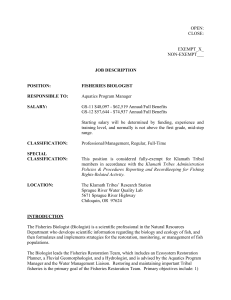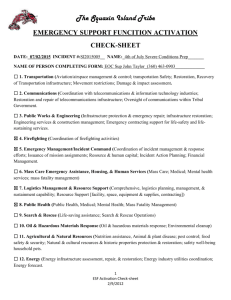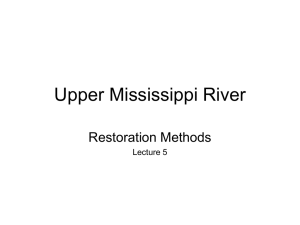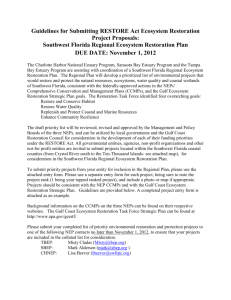OPEN
advertisement
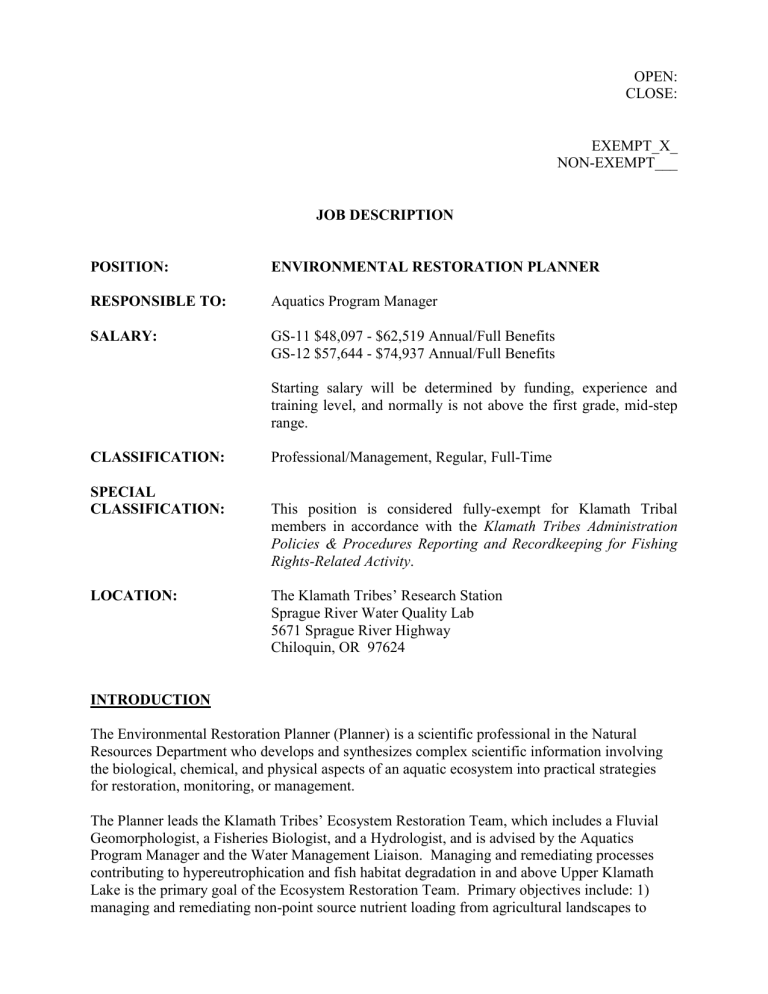
OPEN: CLOSE: EXEMPT_X_ NON-EXEMPT___ JOB DESCRIPTION POSITION: ENVIRONMENTAL RESTORATION PLANNER RESPONSIBLE TO: Aquatics Program Manager SALARY: GS-11 $48,097 - $62,519 Annual/Full Benefits GS-12 $57,644 - $74,937 Annual/Full Benefits Starting salary will be determined by funding, experience and training level, and normally is not above the first grade, mid-step range. CLASSIFICATION: SPECIAL CLASSIFICATION: LOCATION: Professional/Management, Regular, Full-Time This position is considered fully-exempt for Klamath Tribal members in accordance with the Klamath Tribes Administration Policies & Procedures Reporting and Recordkeeping for Fishing Rights-Related Activity. The Klamath Tribes’ Research Station Sprague River Water Quality Lab 5671 Sprague River Highway Chiloquin, OR 97624 INTRODUCTION The Environmental Restoration Planner (Planner) is a scientific professional in the Natural Resources Department who develops and synthesizes complex scientific information involving the biological, chemical, and physical aspects of an aquatic ecosystem into practical strategies for restoration, monitoring, or management. The Planner leads the Klamath Tribes’ Ecosystem Restoration Team, which includes a Fluvial Geomorphologist, a Fisheries Biologist, and a Hydrologist, and is advised by the Aquatics Program Manager and the Water Management Liaison. Managing and remediating processes contributing to hypereutrophication and fish habitat degradation in and above Upper Klamath Lake is the primary goal of the Ecosystem Restoration Team. Primary objectives include: 1) managing and remediating non-point source nutrient loading from agricultural landscapes to measurably reduce cyanobacterial blooms and the related adverse water quality in Upper Klamath Lake; and 2) rehabilitating and maintaining habitats to the extent necessary to recover and sustain important native fisheries, including Lost River and shortnose suckers, redband trout, steelhead, and Chinook salmon. In addition, the Planner participates in the Klamath Tribes’ Fisheries Restoration Team, which is led by the Fisheries Biologist, includes a Fluvial Geomorphologist and a Hydrologist, and is advised by the Aquatics Program Manager and the Water Management Liaison. Restoring and maintaining important Tribal fisheries is the primary goal of the Fisheries Restoration Team. Primary objectives include: 1) re-establishing extinct spawning populations of endangered Lost River and shortnose suckers; and 2) re-introducing extinct populations of Chinook salmon in the Upper Klamath River Basin. Under the general guidance of the Aquatics Program Manager, the Planner develops and implements strategies to achieve the Tribes’ goals and objectives, in compliance with applicable Tribal and Federal policies, procedures, and regulations. The Planner will collaborate with professionals from diverse specialties (fluvial geomorphology, hydrology, fisheries biology, water management, limnology, soils, agriculture, etc.), as well as with private landowners, to seek restoration outcomes that meet the Tribes’ goals and objectives in a manner that also works for riparian landowners. MAJOR DUTIES AND RESPONSIBILITIES 1. Collect and analyze data, especially in relation to non-point source nutrient loading, to determine environmental conditions and restoration needs. 2. Lead the Klamath Tribes’ Ecosystem Restoration Team to create and implement an Aquatic Ecosystem Restoration Plan for the Upper Klamath Basin. 3. Participate in the Klamath Tribes’ Fisheries Restoration Team to create and implement a Fisheries Restoration Plan for the Upper Klamath Basin. 4. Use remote sensing data sets (e.g. digital elevation models derived from LiDAR and hydroacoustics, thermal infrared radiometry, aerial photos, etc.) and GIS software in study design, data analysis, and interpretation. 5. Create and use computer models simulating effects of land and water management alternatives on non-point source nutrient loading, riparian plant community dynamics, or other important ecosystem function. 6. Collaborate with professionals from diverse fields (fluvial geomorphology, hydrology, fisheries biology, water management, limnology, soils, agriculture, etc.) in developing and implementing ecosystem and fisheries restoration and monitoring strategies. 7. Develop and implement monitoring strategies to evaluate results of restoration actions; manage existing long-term monitoring projects to track changes in nutrient loading, water quality, and temperature in the Upper Klamath Basin; includes supervising field data collection, monitoring design, data QA/QC, analysis, and reporting. Job Description Environmental Restoration Planner Page 2 of 6 8. Communicate strategies and findings to diverse end-users, from lay people to other professionals. 9. Acquire, and ensure compliance with, permits required for implementing restoration projects. 10. Write grant proposals and administer grants designed to perform the work necessary to achieve the ecological goals of the Klamath Tribes. 11. Manage budgets and assist with planning for programs within the department. Review and monitor expenditures to remain within established budgetary constraints. 12. Exercise the full range of supervisory duties for assigned staff. Perform overall work planning, establish work schedules and priorities, and assign and review work. Personally discuss the progress of the work and problems areas as they may arise. Recommend employee status and other personnel changes, approve leave, evaluate performance, identify training needs, and ensure that training opportunities are provided. Resolve complaints or minor grievances, and advise employees on matters related to less than satisfactory performance. Keep employees informed of management policies and goals. 13. Attend and facilitate meetings with diverse stakeholders. 14. Other duties as assigned. SUPERVISORY CONTROLS The Environmental Restoration Planner is directly supervised by the Aquatics Program Manager. This position is expected to work independently, using professional knowledge and judgment in ensuring that duties and responsibilities are carried out in a timely manner and that policy and procedures are followed. The Environmental Restoration Planner must exercise good judgment in working with the public, agencies, and other entities. The supervisor outlines the overall Tribal and project objectives and priorities, timelines and financial resources available. The employee plans and schedules recurring work, handles problems and completes work using own initiative, exercising judgment according to training, experience and instructions. Work is reviewed for compliance with policy, procedures and goal attainment. The Environmental Restoration Planner will directly supervise staff necessary to accommodate project-specific assignments in accordance with policies and procedures adopted by the Klamath Tribes. KNOWLEDGE, SKILLS, AND ABILITIES Knowledge and ability to integrate diverse technical information into effective, implementable ecosystem restoration action, and to monitor the result. Knowledge of nutrients (nitrogen and phosphorus), their chemistries, and pertinent storage and transport mechanisms in floodplain ecosystems. Job Description Environmental Restoration Planner Page 3 of 6 Knowledge and ability to design and implement scientific investigations into how land use influences movement of nutrients into surface waters through shallow groundwater and surface runoff. Knowledge and ability to develop and use computer models to simulate the effects of restoration and land use alternatives in an agricultural landscape on non-point source loading of nutrients to surface waters. Skilled user of Microsoft Office products, especially Word, Excel, PowerPoint, and Access. Knowledge and ability to perform statistical analyses using software like R, Systat, SAS, or other statistical packages. Knowledge and ability to use ArcGIS software for mapping and planning, and for analysis of remote sensing products like LiDAR, thermal infrared radiometry, aerial photos, satellite imagery, etc. Knowledge of aquatic ecology, fish biology, hydrology, riparian plant ecology, and limnology. Knowledge of agricultural operations, especially management of soils, irrigated pasture and the associated grazing, and how they can influence hydrology (surface and shallow groundwater), and functional processes in streams. Ability to collaborate effectively with other scientists, and to assume a leadership role in such interactions, especially in regard to leading the Tribes’ Ecosystem Restoration Team in which an atmosphere of collegial teamwork will be essential. Must be able to interact with people of diverse backgrounds in a professional manner, using tact, diplomacy, and mature judgment while pursuing tribal interests. Skilled in conveying complex scientific information in a manner appropriate to a range of audiences, from layman to peer. Ability to perform work and accomplish tasks in accordance with established policies, procedures, practices, and priorities of the Natural Resources Department. This includes the ability to plan and organize work using one’s own initiative and to seek information and assistance from other sources as necessary to meet programmatic goals and deadlines. Ability to develop competitive grant applications. Ability to work an irregular work schedule, which may require work in inclement weather and rugged terrain. Ability to perform tasks which require constant bending, lifting (up to 60 lbs), stretching, and stooping. Ability to operate a vehicle in adverse weather (e.g. snowy conditions) and on rugged forest roads. Ability to operate power boats in challenging (high winds, large waves, shallow water, etc.) conditions. QUALIFICATIONS, EXPERIENCE, AND EDUCATION Job Description Environmental Restoration Planner Page 4 of 6 Master of Science Degree in Environmental Engineering, Environmental Science, Restoration Ecology, or closely related field, REQUIRED (copy of degree and transcripts must be submitted with application). Two (2) years demonstrated work experience integrating the concepts of aquatic ecosystem restoration, aquatic or riparian ecology, and nutrient dynamics into recommendations or alternatives leading to restoration actions, REQUIRED. Two years supervisory experience, REQUIRED. Demonstrated ability to write well, concisely communicating complex information to a variety of audiences, REQUIRED. Please submit with your application a 2-5 page sample of a document authored by you. Demonstrated ability to lead people with diverse backgrounds and viewpoints towards collaborative solutions to challenging problems, PREFERRED. Must be dependable and responsible, highly motivated, and willing and able to work independently. Proficiency in the use of computers for a variety of tasks including: o general computing using Microsoft Office (e.g. spreadsheets, documents, presentations, etc.), REQUIRED; o analysis using statistical software (e.g. R, Systat, SAS, or the equivalent), PREFERRED; o computer models simulating flow and nutrient transport processes in aquatic systems (e.g. QUAL2e, SWAT, SPARROW, MIKE, HEC-RAS or the equivalent), REQUIRED; and o mapping and analysis using ArcGIS, PREFERRED. Must possess a valid Driver's License, have a good driving record and be insurable by the Klamath Tribes. Must obtain valid Oregon Driver’s License within the initial 90-day probationary period as a condition of employment, REQUIRED (copy of a valid Driver’s License must be submitted with application). Must be able to operate power boats, and to obtain an Oregon Boater Education Card within the initial 90-day probationary period as a condition of employment, REQUIRED. Must submit to and clear an alcohol/drug screen test, REQUIRED (employment will be contingent upon clearing the required alcohol/drug screening test). Indian Preference will apply (must submit proof of Indian Preference with application). ACKNOWLEDGEMENT This job description is intended to provide an overview of the requirements of the position. It is not necessarily all-inclusive, and the job may require other essential and/or non-essential functions, tasks, duties, or responsibilities not listed herein. Management reserves the sole right to add, modify, or exclude any essential or non-essential requirement at any time with or without notice. Nothing in this job description, or by the completion of any requirement of the job by the employee, is intended to create a contract of employment of any type. Job Description Environmental Restoration Planner Page 5 of 6 Revised: 9/13 APPLICATION PROCEDURES Submit a Tribal Application for Employment with all requirements and supporting documentation to: The Klamath Tribes ATTN: Human Resource P.O. Box 436 Chiloquin, OR 97624 Phone: (541) 783-2219 ext. 104 or 190 IT IS THE RESPONSIBILITY OF THE APPLICANT TO PROVIDE SUFFICIENT INFORMATION TO PROVE QUALIFICATIONS FOR TRIBAL POSITIONS. PLEASE NOTE: If requirements are not met (for example, submission of a resume in lieu of a tribal application, or not including a required certification), your application will not be reviewed and will be disqualified. Indian Preference will apply. In accordance with Klamath Tribal policy, priority in selection will be given to qualified applicants who present proof of eligibility for "Indian Preference". Applications will not be returned. Job Description Environmental Restoration Planner Page 6 of 6

